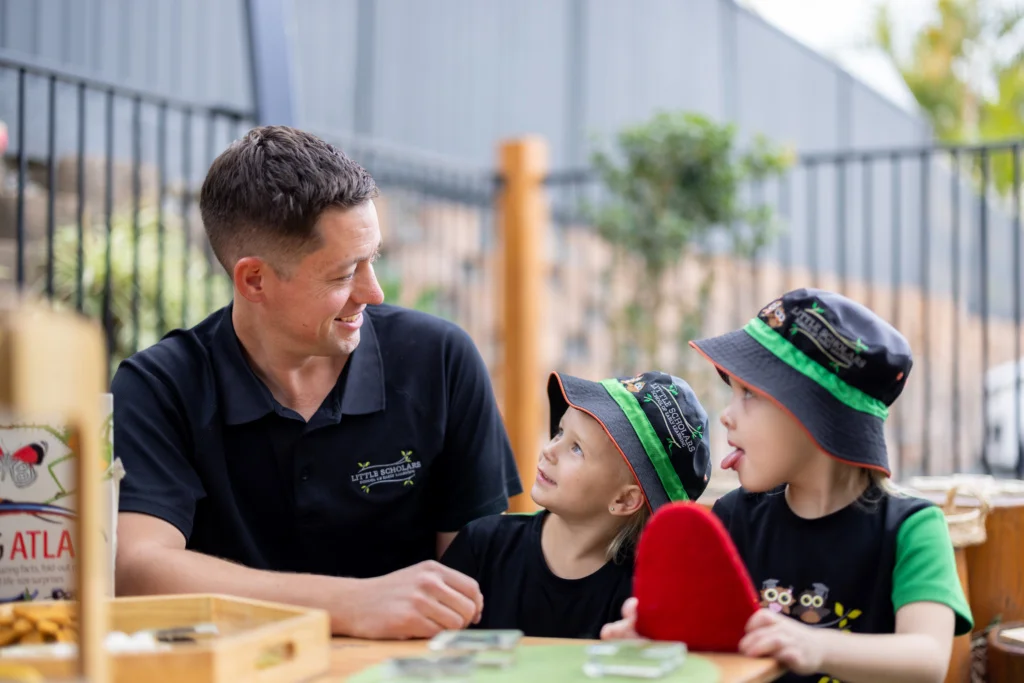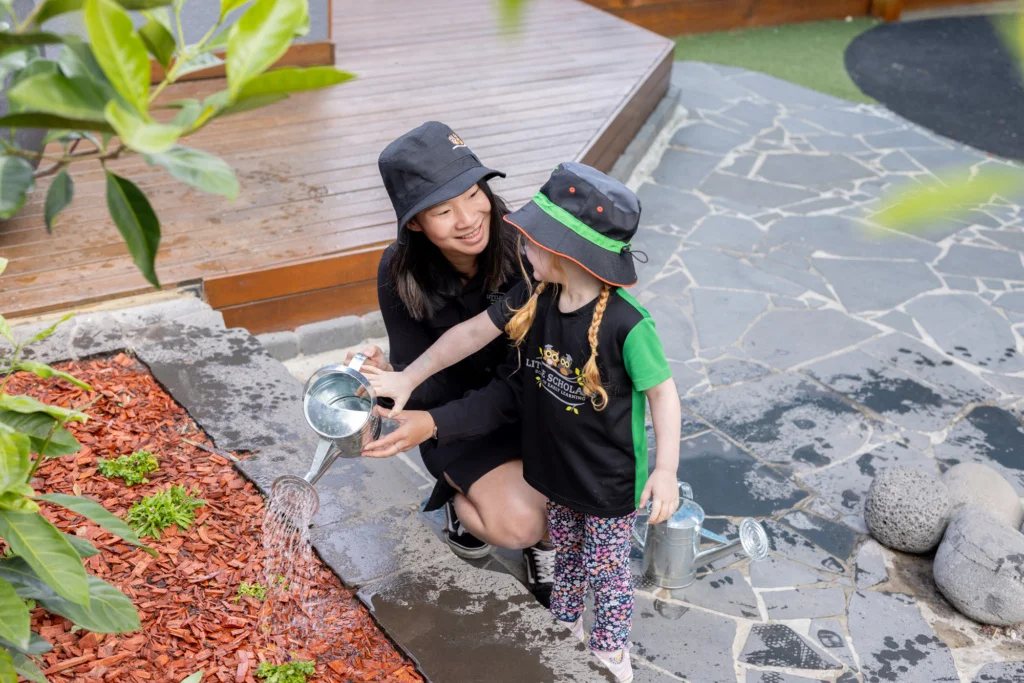When a baby or toddler is ready to reduce the number of naps they have each day, or even drop naps altogether, this can be an equally challenging transition for parents!
Daytime naps naturally lessen in length and frequency as a child gets older because they can tolerate more awake time, from both a physiological and neurological perspective as they grow. Circadian rhythms – your 24-hour body clock that helps control your daily schedule for sleep and wakefulness – also mature as sleep begins to consolidate, particularly at night.
Especially for new parents, you may be wondering what some of the signs are that your child is ready to drop a nap. Dropping a nap is a transition that happens over time. Babies need to decrease their number of naps incrementally, but that won’t happen on its own, babies and toddlers still need your guidance to help ease these changes. And our educators are here to help.
Since our educators spend a few days a week with your little one, they have the knowledge of what to look for in signs of tiredness, or readiness to stay awake just a little longer! It’s important to remember that each child is different. What works for one, won’t work for another exactly the same age or way, and this is not a process to rush, small people need their rest!
Here are some signs that may show your little one is ready to drop a nap:
“For some children, cutting down their bottles or altering their times they have bottles (obviously age-appropriate) may help with stretching wake windows,” says Hayley, an educator with our Deception Bay campus.
“We aim to wake the child through gentle means, such as hustle and bustle around them to help them wake more naturally, which can help too.”
Hayley says looking at wake windows as a guide for your child can help and you can find free resources and blogs by sleep experts online. But she says keep in mind small children going through leaps and teething may have more difficulty with their sleep, but these adjustments are usually temporary.
Keeara, an educator in the nursery at our Yatala campus says they’ve had some parents request help in stretching their child’s nap to one sleep to transition in the toddler room.
They find play in an outdoor environment during the morning keeps little ones occupied enough to stay awake – but says if their children did fall asleep, it was obviously needed, and educators will try for a short afternoon nap to make up for it.
Fresh air and active fun like sensory activities are a great way to stretch that wake time out a little longer for little ones. Maybe for your child, it’s making music or playing with different textures that will keep him or her engaged and interested just a little longer.
Our Facebook and Instagram channels offer ideas on creative activities our educators do across our campuses to entertain little ones, which can really help stretch out those wake windows.
Like Hayley, Keeara and her fellow educators have also found works is having lunch around 11:30 and putting bottles on the warmer at the same time so they’re ready to go when lunch is finished.

“We’ve found most of the children would have their bottle then self-settle in their cots as they were so exhausted at this point,” Keeara says. “Surprisingly, it worked really well and made the transition smoother, they even slept for a longer period of time having just the one sleep.”
Then comes the (often dreaded by parents) time when children are ready to drop naps completely.
“We have a fair few two-three-year-olds in our room who have dropped sleep,” says Skye, an educator at our Yatala campus. “The most common sign for them was becoming upset at rest time, moving around a lot and getting up for drinks, toilet and to just tell us something.”
She says even if educators suspect a child is ready to drop naps, they start off with still giving the child a bed, but giving them a quiet activity like books, puzzles, or drawing supplies.
“That way they still have the option to fall asleep if they want to, if they haven’t slept the whole week, we then move them to an activity mat that we keep clear of beds, again for quiet activities while their peers sleep,” Skye says.
Independent play is also important for your child’s development, and it’s central to effective quiet time, so it’s worthwhile implementing it into your older toddler’s daily routine. Quiet time is a time during the day where your child has an opportunity to rest their busy little bodies and minds. The length of quiet time can range anywhere from 45 minutes to 2 hours, depending upon the child, but consistency in this new quiet time will work wonders for the whole family.
Skye says dropping naps is something they talk to parents about, and from those discussions, they work together on a plan to help the child adjust.
No matter your age, communication is an important skill. For pre-schoolers though, their ability to communicate and listen to instructions is a steep learning curve in their development. At times, it can be frustrating if an adult can’t understand what the child is saying or the child can’t use words to share what they mean. Learning effective communication is a crucial part of child development. During the preschool years, a child will have enough vocabulary to engage in simple conversations as well as share how they feel. To encourage positive communication with children, here are some powerful tips.

A preschool child will either share in detail what they know when re-sharing a story or they may only give basic information about the event. To keep the lines of communication open between a child and adult, rather than listen to respond, listen to understand. Your child wants to know you understand them, no matter how significant or insignificant the event may seem to you. It’s important that children feel free to speak as this can build their confidence and esteem when communicating. This can also be foundational to future conversations as the child gets older.

To help children feel more comfortable when communicating with you, bend so that you are at their eye level. This proactively shows you are listening to what they are saying and are paying attention. It also builds the connection between adults and children.
There will be times when challenging behaviour by the child will need to be addressed but it is important to deliver negative feedback in a way that leaves the child with a positive outlook. This is important for a child to experience as it prepares them for how they manage negative conversations in the future. Bending and speaking calmly to a child about their behaviour can help the child feel less intimidated so they can comprehend what is being said to them. Giving them some gentle guidance about how they could make a better choice next time helps them to feel positive about the interaction.
Communication is developed through expressing how one feels. When a child opens up about how they feel, they want to be acknowledged. Don’t dismiss what they share by saying ‘stop crying’, or ‘you’re being silly’. These can make the child feel invalidated and is a surefire way for them to conceal how they feel in the future. Crying is a human emotion and to a child, whatever they’re upset about is important to them. We want children to feel comfortable sharing their feelings and emotions. ‘It seems like you’re feeling really _____, that must feel hard.’
You could also show you’re curious about their emotions, which may open up the communication with your child. “You seem mad, I wonder why you’re feeling mad at mummy?’
Keep the lines of communication open by offering empathy. Respond with something like, ‘I want you to know you can share anything with me, I will love you no matter what. I’m here for you.’ This will help them share how they feel with no fear of judgement so they don’t feel unheard or misunderstood.
Children can say and do things that can provoke an emotional response from you. Positive communication with children relies a lot on how you control your emotions. Refrain from saying words that you may regret later. Control strong outbursts and try to remain calm – especially when bad behaviour occurs. Counting to 10 before responding to a child can be a great way to help diffuse emotions, before speaking them out.
When talking to children, be clear with instructions and confident when delivering them. If a child can sense a lack of confidence in the way you speak to them, they will often do the opposite of what has been asked. The delivery of communication is important for mutual respect to occur.
The best way for your child to understand positive communication skills is to practice them! Whether it’s talking about a book you’re reading together, or role playing as you play together, there are lots of subtle activities to help your child improve his or her communications in a positive way.
The way you speak to children not only reflects your character, but also leads by example. Children will imitate the behaviour they see. Be assertive when communicating, so your child can learn to be assertive when communicating with others.
At Little Scholars, we pride ourselves on maintaining respectful and positive communication with children at all times. Discover how we can help your little one express their full potential. Contact Us.
At Little Scholars School of Early Learning, we’re dedicated to shaping bright futures and instilling a lifelong passion for learning. With our strategically located childcare centres in Brisbane and the Gold Coast, we provide tailored educational experiences designed to foster your child’s holistic development.
Let us hold your hand and help looking for a child care centre. Leave your details with us and we’ll be in contact to arrange a time for a ‘Campus Tour’ and we will answer any questions you might have!
"*" indicates required fields